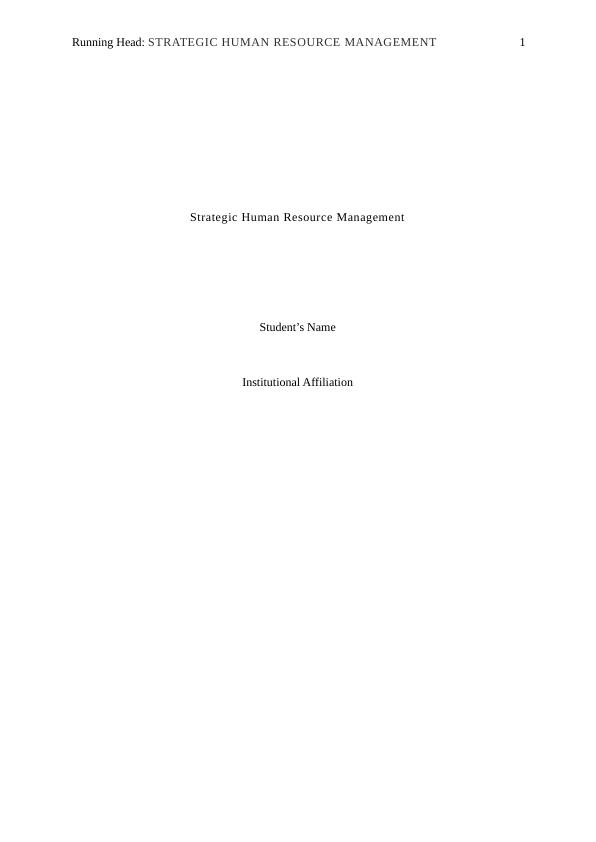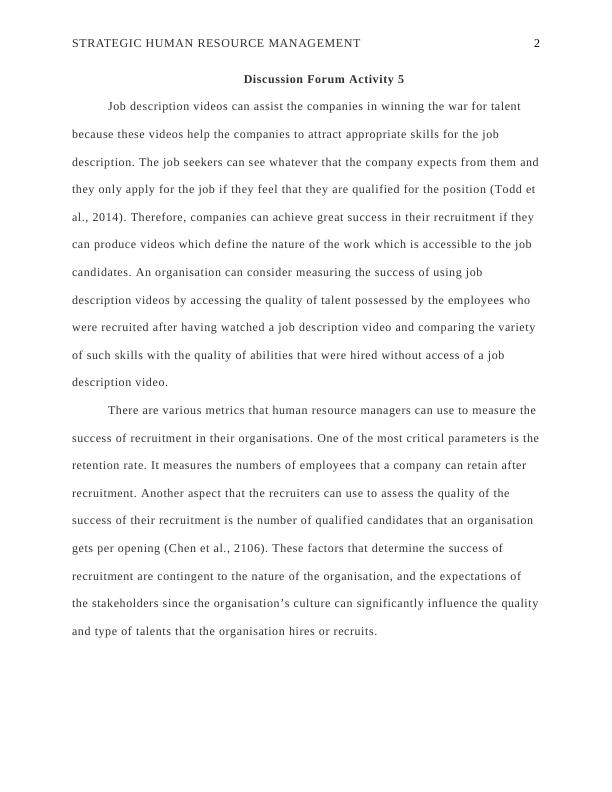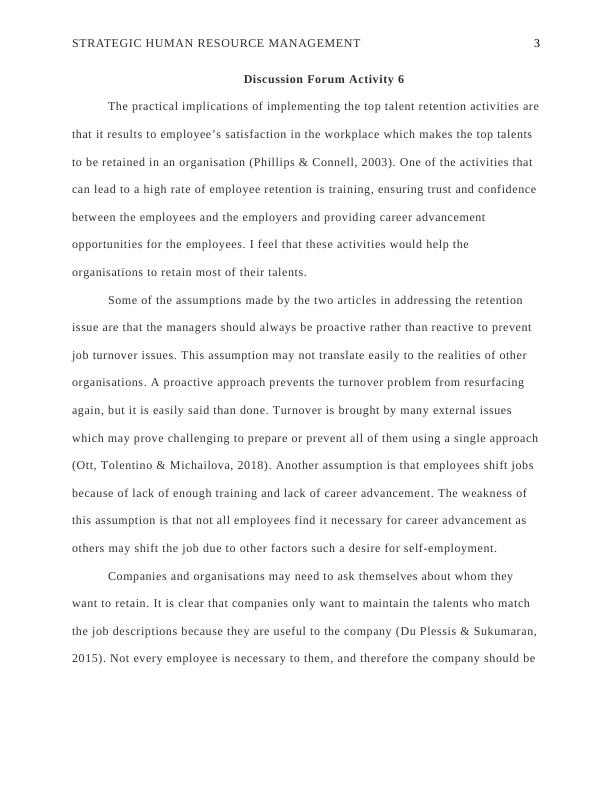Strategic Human Resource Management
Added on 2023-04-19
8 Pages1792 Words418 Views
Running Head: STRATEGIC HUMAN RESOURCE MANAGEMENT 1
Strategic Human Resource Management
Student’s Name
Institutional Affiliation
Strategic Human Resource Management
Student’s Name
Institutional Affiliation

STRATEGIC HUMAN RESOURCE MANAGEMENT
Discussion Forum Activity 5
Job description videos can assist the companies in winning the war for talent
because these videos help the companies to attract appropriate skills for the job
description. The job seekers can see whatever that the company expects from them and
they only apply for the job if they feel that they are qualified for the position (Todd et
al., 2014). Therefore, companies can achieve great success in their recruitment if they
can produce videos which define the nature of the work which is accessible to the job
candidates. An organisation can consider measuring the success of using job
description videos by accessing the quality of talent possessed by the employees who
were recruited after having watched a job description video and comparing the variety
of such skills with the quality of abilities that were hired without access of a job
description video.
There are various metrics that human resource managers can use to measure the
success of recruitment in their organisations. One of the most critical parameters is the
retention rate. It measures the numbers of employees that a company can retain after
recruitment. Another aspect that the recruiters can use to assess the quality of the
success of their recruitment is the number of qualified candidates that an organisation
gets per opening (Chen et al., 2106). These factors that determine the success of
recruitment are contingent to the nature of the organisation, and the expectations of
the stakeholders since the organisation’s culture can significantly influence the quality
and type of talents that the organisation hires or recruits.
2
Discussion Forum Activity 5
Job description videos can assist the companies in winning the war for talent
because these videos help the companies to attract appropriate skills for the job
description. The job seekers can see whatever that the company expects from them and
they only apply for the job if they feel that they are qualified for the position (Todd et
al., 2014). Therefore, companies can achieve great success in their recruitment if they
can produce videos which define the nature of the work which is accessible to the job
candidates. An organisation can consider measuring the success of using job
description videos by accessing the quality of talent possessed by the employees who
were recruited after having watched a job description video and comparing the variety
of such skills with the quality of abilities that were hired without access of a job
description video.
There are various metrics that human resource managers can use to measure the
success of recruitment in their organisations. One of the most critical parameters is the
retention rate. It measures the numbers of employees that a company can retain after
recruitment. Another aspect that the recruiters can use to assess the quality of the
success of their recruitment is the number of qualified candidates that an organisation
gets per opening (Chen et al., 2106). These factors that determine the success of
recruitment are contingent to the nature of the organisation, and the expectations of
the stakeholders since the organisation’s culture can significantly influence the quality
and type of talents that the organisation hires or recruits.
2

STRATEGIC HUMAN RESOURCE MANAGEMENT
Discussion Forum Activity 6
The practical implications of implementing the top talent retention activities are
that it results to employee’s satisfaction in the workplace which makes the top talents
to be retained in an organisation (Phillips & Connell, 2003). One of the activities that
can lead to a high rate of employee retention is training, ensuring trust and confidence
between the employees and the employers and providing career advancement
opportunities for the employees. I feel that these activities would help the
organisations to retain most of their talents.
Some of the assumptions made by the two articles in addressing the retention
issue are that the managers should always be proactive rather than reactive to prevent
job turnover issues. This assumption may not translate easily to the realities of other
organisations. A proactive approach prevents the turnover problem from resurfacing
again, but it is easily said than done. Turnover is brought by many external issues
which may prove challenging to prepare or prevent all of them using a single approach
(Ott, Tolentino & Michailova, 2018). Another assumption is that employees shift jobs
because of lack of enough training and lack of career advancement. The weakness of
this assumption is that not all employees find it necessary for career advancement as
others may shift the job due to other factors such a desire for self-employment.
Companies and organisations may need to ask themselves about whom they
want to retain. It is clear that companies only want to maintain the talents who match
the job descriptions because they are useful to the company (Du Plessis & Sukumaran,
2015). Not every employee is necessary to them, and therefore the company should be
3
Discussion Forum Activity 6
The practical implications of implementing the top talent retention activities are
that it results to employee’s satisfaction in the workplace which makes the top talents
to be retained in an organisation (Phillips & Connell, 2003). One of the activities that
can lead to a high rate of employee retention is training, ensuring trust and confidence
between the employees and the employers and providing career advancement
opportunities for the employees. I feel that these activities would help the
organisations to retain most of their talents.
Some of the assumptions made by the two articles in addressing the retention
issue are that the managers should always be proactive rather than reactive to prevent
job turnover issues. This assumption may not translate easily to the realities of other
organisations. A proactive approach prevents the turnover problem from resurfacing
again, but it is easily said than done. Turnover is brought by many external issues
which may prove challenging to prepare or prevent all of them using a single approach
(Ott, Tolentino & Michailova, 2018). Another assumption is that employees shift jobs
because of lack of enough training and lack of career advancement. The weakness of
this assumption is that not all employees find it necessary for career advancement as
others may shift the job due to other factors such a desire for self-employment.
Companies and organisations may need to ask themselves about whom they
want to retain. It is clear that companies only want to maintain the talents who match
the job descriptions because they are useful to the company (Du Plessis & Sukumaran,
2015). Not every employee is necessary to them, and therefore the company should be
3

End of preview
Want to access all the pages? Upload your documents or become a member.
Related Documents
Resourcing the Organisationlg...
|6
|1272
|61
Human Resourcelg...
|17
|4572
|39
Human Resource Management | Essaylg...
|10
|2751
|49
Strategic Resourcing and Talent Managementlg...
|7
|1907
|66
Different Stages of Human Resource Life Cycle in Travel and Tourismlg...
|14
|983
|63
Attracting And Retaining Stafflg...
|16
|3741
|337
